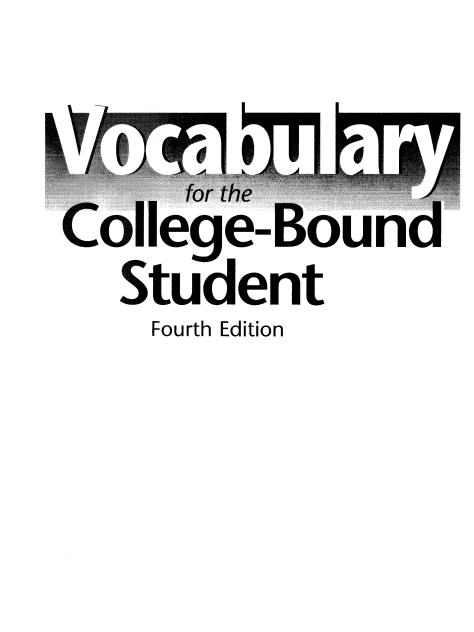

اگر به یک وب سایت یا فروشگاه رایگان با فضای نامحدود و امکانات فراوان نیاز دارید بی درنگ دکمه زیر را کلیک نمایید.
ایجاد وب سایت یا
مشخصات کتاب
نام کتاب:Vocabulary For The College-Bound Student
نویسندگان:HAROLD LEVINE, Benjamin Cardozo and NORMAN LEVINE
تعداد صفحات: 58
فرمت فایل: PDF
این روزها در حوزه ی لغت یا همانvocabularyصحبت از کتاب ارزشمندVocabulary For The College-Bound Studentزیاد به میان می آید.
این کتاب پر بار در هر فصل خود نکاتی را برای درک بهتر واژگان برای زبان آموزان خود مطرح می دارد.
برای هر نکته هم لغات و تمریناتی در نظر گرفته شده است.
Introduction
Vocabulary for the College-Bound Student has been at the top of its field for three decades. Youll find that it results in true vocabulary expansion rather than "test it and forget it" learning. The aim of the book is to help students learn to recognize new words in their reading and also to use them in their writing and conversation. Students will build vocabularies that will stay with them long after they take their college entrance exams.
Some of the methods youll find in Vocabulary for the College-Bound Student are:
1. learning new words from the context in which they are used, 2. learning vocabulary in groups of related words, 3. learning vocabulary derived from Greek and Latin, and 4. learning vocabulary borrowed from French, Italian, and Spanish
In the "Expanding Vocabulary Through Derivatives" chapter, students practice combining prefixes, suffixes, and roots to make new words. This chapter is especially important because once students see how words are made, they can often determine the meanings of new words they encounter. If they already know what service, advantageous, and assemble mean, just by learning the prefix dis, they can add three more words to their vocabularies: disservice, disadvantageous, and disassemble.
In Chapter 12, students will complete sample questions for pre-college tests. While the goal of doing well on the SAT or ACT may be the primary motivator for your students to study vocabulary, we hope the activities in the textbook as well as those in this manual will help you to engage students in the pleasurable activity of learning and using new words because they want to, not because they have to.
The chapters do not ask students to spend hours looking up definitions in the dictionary. Instead, for each word there is a definition, pronunciation guide, and in most cases a sample sentence. Students study these and then apply their knowledge by completing several types of exercises, some of which are listed below.
1. Synonym Match-This is a time-tested way to for students to self-check
simple comprehension of the new words.
2. Opposites—This takes the Synonym Match one step further. The student
must know two things: what a word means, and what its opposite means.
3. Find the Unrelated Word in a Group of Four-As students consider four words
in a group, they are seeing three synonyms plus an unrelated word. This
visually reinforces word meanings. 4. Sentence Completion-Given a list of words, students fill in the blanks in
sentences. This shows them how the words can be used in writing and
speaking. 5. Concise Writing-These exercises ask students to use a vocabulary word and
a limited number of other words to restate a thought expressed in a longer sentence. For example, "His weakness is that he is excessively concerned about his personal appearance" can be restated as "His weakness is vanity." If your students have problems with rambling and imprecise sentences when they write compositions, these Concise Writing exercises will help
them to understand that, in writing, "less" is often "more." 6. Brainteasers-Students fill in the missing letters to complete sentences. This
exercise causes students to do a lot of skimming through words and definitions as they try to find the word that fits exactly into the spaces, and
this furthers learning. 7. Composition - The composition activities pose questions using list words, for
example, "Why is it difficult for vain individuals to admit they are fallible?" Students are asked to answer in two or three sentences. Here, they must apply critical thinking skills to see how vanity and fallibility relate to one
another. 8. Close Reading-In this type of exercise, students read a group of statements
and then answer questions which use vocabulary words. Heres an example: One statement reads, "The recreation supervisor was able to find a way to stop the almost daily bitter fights we were having over the use of the tennis courts." In the list of questions, one question reads, "Who resolved a nettlesome problem?" The answer, of course, is the recreation supervisor. Again, critical thinking skills come into play as students look for questions
that relate to situations presented in the statements. 9. Analogies-Many students and teachers consider analogies the most difficult
vocabulary activity, but meeting the challenge can be both satisfying and enlightening. Analogies really home in on the precise meanings of words and their relationships to one another. Weve included a section on pages 9-10 that will help you provide some tips and tricks for teaching analogies.
On the next two pages is a two-semester plan for using Vocabulary for the College-Bound Student. Of course, you may want to modify and adjust the plan. You may decide that your students are already so familiar with Spanish loanwords that you dont need to use that chapter at all. Perhaps youll want to spend extra time on derivatives, or complete the chapter on pre-college testing just before your students take the SAT or ACT. If your students have already taken their college entrance exams, and your course is aimed at building their vocabularies before they go off to college, you may want to omit Chapter 12 and spend more time on another chapter or on longer composition activities.
مبلغ قابل پرداخت 30,845 تومان
برچسب های مهم